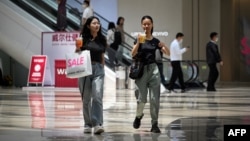As much of the Western world continues to struggle with higher than usual rates of inflation, China faces a very different problem: potential price deflation, which could signal serious economic trouble in the future.
On Monday, official data showed that consumer prices in June had barely risen compared to a year earlier. Excluding the volatile food and energy sectors, inflation was still surprisingly low, at just 0.4% per year.
At the same time, China’s producer price index, which measures what manufacturers charge for their goods, showed a dramatic 5.4% year-over-year decline. This signal of wholesale price deflation appears to be the result of decreased demand, which bodes ill for Chinese manufacturers.
Counterintuitive crisis
While lower prices for goods may seem like good news for consumers, widespread price declines can be very bad news for the broader economy.
High inflation presents a real problem for consumers, but economists believe that a low but steady price inflation is necessary for a healthy economy. The U.S. and other advanced Western economies typically target an inflation rate of about 2% per year.
Very low inflation, or deflation — when prices begin to decline across the broad economy — can significantly hamper economic growth.
Signal of weakness
“Deflation is a signal of weakness and lack of confidence in the economy,” Gary Jefferson, the Carl Marks Professor of International Trade and Finance at Brandeis University, told VOA. He said that it is often caused by low demand for goods and services and can have a number of negative effects.
“If people see prices are falling, then they may be more likely to delay their purchases, knowing that next week or next month, they can buy a car or a house at a lower price,” said Jefferson, who studies the Chinese economy. “And so it tends to further depress spending in the present in the expectation that a better deal could be had in the future.”
While it increases the purchasing power of a fixed amount of money, deflation also puts downward pressure on business profits, which can in turn push down wages and employment as well as reducing the incentive to invest in further productive capacity.
Significantly for China, deflation also makes it more difficult for borrowers to service their debts, as the rising value of money makes fixed loan payments more expensive relative to the cost of other goods and services. Many Chinese businesses and local governments are currently carrying very high levels of debt, complicating their financial future as they face declining revenues.
Local government indebtedness
The financial struggles of local governments are particularly relevant to China’s current difficulties, because in the past they have served as a conduit for economic stimulus packages. In a statement emailed to VOA, Ian Hutchinson, a spokesperson for the Rhodium Group, an independent research organization, said that is no longer a viable option for Beijing.
“Some recent research we did looking at the debt of local government financing vehicles showed that [local government financing vehicles, or LGFVs] alone hold over 59 trillion yuan [$8.16 trillion] in interest-paying debt and payables, around 50% of China’s GDP,” he wrote. “Those LGFVs are also facing a significant cash crunch — only around a fifth of them have enough cash on hand to pay their short-term obligations.”
He added, “So how does that relate to economic stimulus? In the past, fiscal stimulus channeled through local government investment has been a key tool for Beijing to exert influence over the economy. Since these localities are struggling to make ends meet, they aren’t effective tools for Beijing to juice the economy unless there’s a restructuring of their debt obligations.”
Long-term trend
Loren Brandt, the Noranda Chair Professor of Economics at the University of Toronto, told VOA that the dim economic outlook for China is consistent with a long-term trend that has seen the country’s economy weakening.
“We've seen a marked slowdown of the growth in the Chinese economy, and a lot of what has been underlying that decline has been anemic growth in productivity,” he said.
For several decades, China had enjoyed explosive productivity growth, and boasted double digit economic growth rates as a result. However, in recent years, productivity growth has sharply declined.
Brandt pointed out that this is clearly not just a result of China’s economy catching up with Western rivals and growing at the more sedate pace typical of advanced economies.
“Even if we just take the official numbers, per capita GDP in China is 20% of that of the United States,” Brandt said. Other Asian economies that experienced booming growth from the mid-to-late 1900s and through today did not see a similar slowdown in productivity growth until they reached a level equal to between 40% and 50% of U.S. productivity levels,” he said.
“In China, this decline in GDP growth is happening much earlier in development, and what that suggests is that it's not just in terms of where China happens to be in terms of its development relative to the advanced countries, it's something much more systematic,” Brandt said. “It's likely related to policy, both in terms of internal policy, external policy in terms of how it relates to the rest of the world.”
Options for stimulus
Jefferson, of Brandeis, said that China will likely look to implement some sort of economic stimulus package meant to boost demand. However, he said, whether it will succeed is unclear.
In the past, the Chinese government has pushed stimulus programs focused on infrastructure investment, to the point where returns on further investment in the sector are sharply diminishing.
An alternative, stimulus spending directed at individual households, is likely to run into the reality that consumer confidence in China is currently quite low, Jefferson said. This makes it less likely that investments in human capital, like graduate education, for example, will be seen as worthwhile.
Worldwide impact
Should China continue to struggle with low inflation or even deflation, Jefferson said, the impact will be felt in the U.S. and worldwide.
“It's a kind of double-edged issue for the rest of the world, in that deflation and diminished demand is going to reduce [Chinese] imports from the rest of the world,” he said. “On the other hand, it will make Chinese exports somewhat more price stable or even [less expensive]. That could have some benefit to our effort here, in this country, to promote price stability.”






